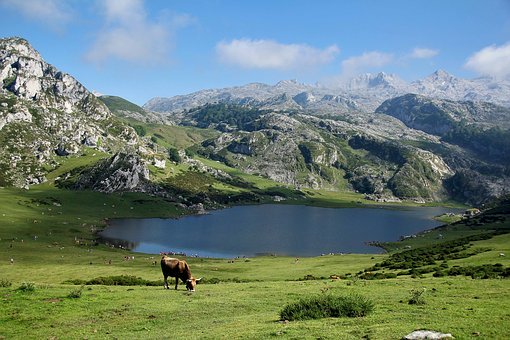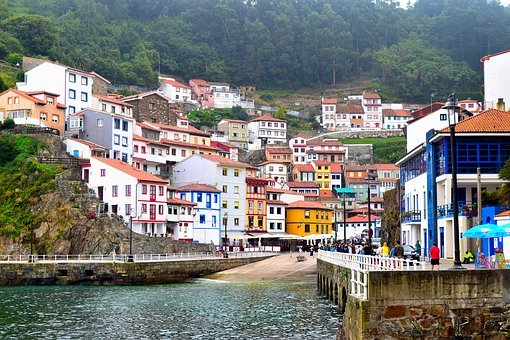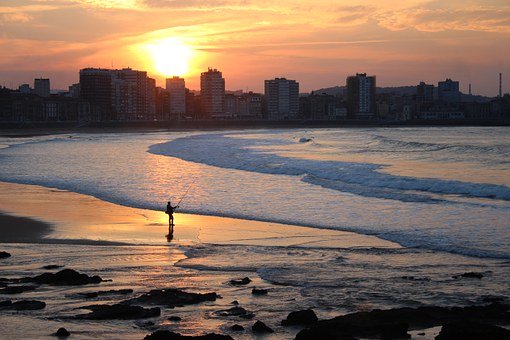Asturias - Peaks and Parks
by Mark Buckingham
Asturias is one of the seventeen
autonomous communities of Spain, and can be found in the far north of the
country. Many of the autonomous communities of Spain are further sub-divided
into provinces and Asturias is no exception albeit there is only one province
in this region, which is also named Asturias.
The autonomous community
is bordered as follows:
-
on the east by Cantabria
-
on the south by Castilla y León
-
on the west by Galicia
-
on the north by the Cantabrian
Sea
The capital of the province,
Oviedo along with the seaport of Gijón
and the industrial town of Avilés are the most important cities
of the region with other major towns including Mieres, Siero, Cangas
de Onís, Cangas del Narcea, Grado, Lena, Laviana, El Entrego,
Villaviciosa and Llanes.

High mountain ranges spanning
some 200 kilometres, characterize the landscape of Asturias and within
these ranges some of Spain's most exceptional nature reserves, such as
Picos de Europa and the national parks of Covadonga and Somiedo, can be
found.
Climbing, walking, skiing
and caving are just some of the activities which are catered for in this
Mecca for sports enthusiasts, whilst the lush green landscapes of the rest
of the region offers peace and tranquillity for the non-extreme amongst
us.
Such is the contrast of the
landscape that the question should be 'Where else could you find high mountain
peaks a few miles from a coastline which has great beaches and colourful
fishing villages?'
As extensive as it is spectacular,
the Asturian coastline is littered with hundreds of beaches, coves and
natural sea caves. Playa del Silencio (Beach of Silence) close to the fishing
village of Cudillero and the many, many beaches, which surround the summer
resort of LLanes, are particularly noteworthy. Barro, Ballota and Torimbia
(which is predominantly a nudist beach) are just a few of these and it
is not unusual to see grazing livestock on top of the steep cliffs which
border most of the fine, sandy beaches.
With an annual rainfall varying
between 1m and 1.5m, the province can claim to be one of the wettest in
the Iberian peninsular and Degaña, with its average of 2.13m per
year is one of the wettest areas within the region. The mountainous areas
of Asturias have, predictably, harsh and bitterly cold winter periods,
whilst in contrast, the coast enjoys mild summers and winters with yearly
average temperatures in Oviedo being 13ºC. Snowfall is commonplace
in the Somiedo and Picos regions between November and January.

Food and Drink
Asturias is renowned for
both its seafood and for its regional dish Fabada Asturiana, which is a
rich, tasty stew made with large white beans, shoulder of pork, black sausage,
spicy sausage and saffron. The traditional alcoholic drink of the region
is a natural cider made with apples harvested from the many apple groves
here and it is usually served "El Escanciado". The bottle, when using this
method, must be held above head height, which allows the cider to have
a long vertical pour, and since it is bottled without gas, the cider becomes
aerated as it splashes into the glass giving it a pleasant, refreshing
taste. It is customary to pass the same glass around and for everyone to
drink from it.
After each person takes his
or her sip, a small amount of the cider is splashed to the ground in a
symbolic glass cleaning gesture before passing it to the next person.
Asturias is also affectionately
known as "the land of cheeses". This is due chiefly to the wide variety
and quality of the regions famous product (especially the Cabrales).
Tourist Attractions
The Way of Santiago (along
with all of its en-route monuments) and the Ruta de la Plata (the "silver
route") both traverse Asturias and are some of the regions most favourite
tourist attractions.
Music
Regional Anthem - The regional
anthem of Asturias, 'Asturias, patria querdia' (Asturias, my dear motherland),
is a song which, as popular myth suggests, is sung by intoxicated people
across the whole of Spain, whereas in reality this is not actually true.
Francos' side first mentioned this idea during the Spanish civil war in
an effort to damage the reputation of the Asturian people.

Major Attractions
Oviedo, the region's
capital: compromising of a diverse architecture, it is a clean and cosmopolitan
city. Some of the major highlights located to the north, are Santa María
del Naranco and San Miguel de Lillo, a pre-Roman church and a pre-Roman
castle respectively, which were built by the first Asturian Kings.
The Picos de Europa National
Park: The Picu Urriellu is probably the more famous of the mountains
in this range and is a molar-shaped peak which has an orange radiance in
the twilight sun which gives it its nickname of 'El Naranjo de Bulnes'.
The shrine to the Virgin
Mary of Covadonga and the mountain lakes near Cangas
de Onís: The Virgin Mary is said, according to legend, to have
given Asturian soldiers a timely signal to attack the Moorish conquerors,
which by doing so took the aggressors completely by surprise. The result
is that the Reconquista and unification of Spain, it is believed, began
here in Asturias.
The Asturian coast:
the beaches and coves around the resort of LLanes are worthy of particular
mention, as is the Playa del Silencio close to the fishing village of Cudillero.
Other Places of Interest
-
Ceceda village: notice
the traditional horreo grain silos, which are built on stilts which keeps
field mice from getting to the grain.
-
The Dobra River: its
remarkable colours and natural beauty make the river worthy of visiting
if you are in the area.
-
The 'senda costera' (coastal
way) between Pendueles and Llanes: some of the most impressive coastal
scenery can be seen whilst walking along this nature route. Among the many
spectacles are the bufones (water spouts naturally created by sea erosion)
and the Playa de Ballota.
-
A bizarre rock formation on
the beach at Buelna village that is best viewed at low tide.
The mountains and nature reserves
of Asturias offer a timeless way of life, which is steeped in culture and
is enchantingly different from the busy Southern Costas. At least once
in a persons life a visit to Asturais should be on the agenda.
Top
|



